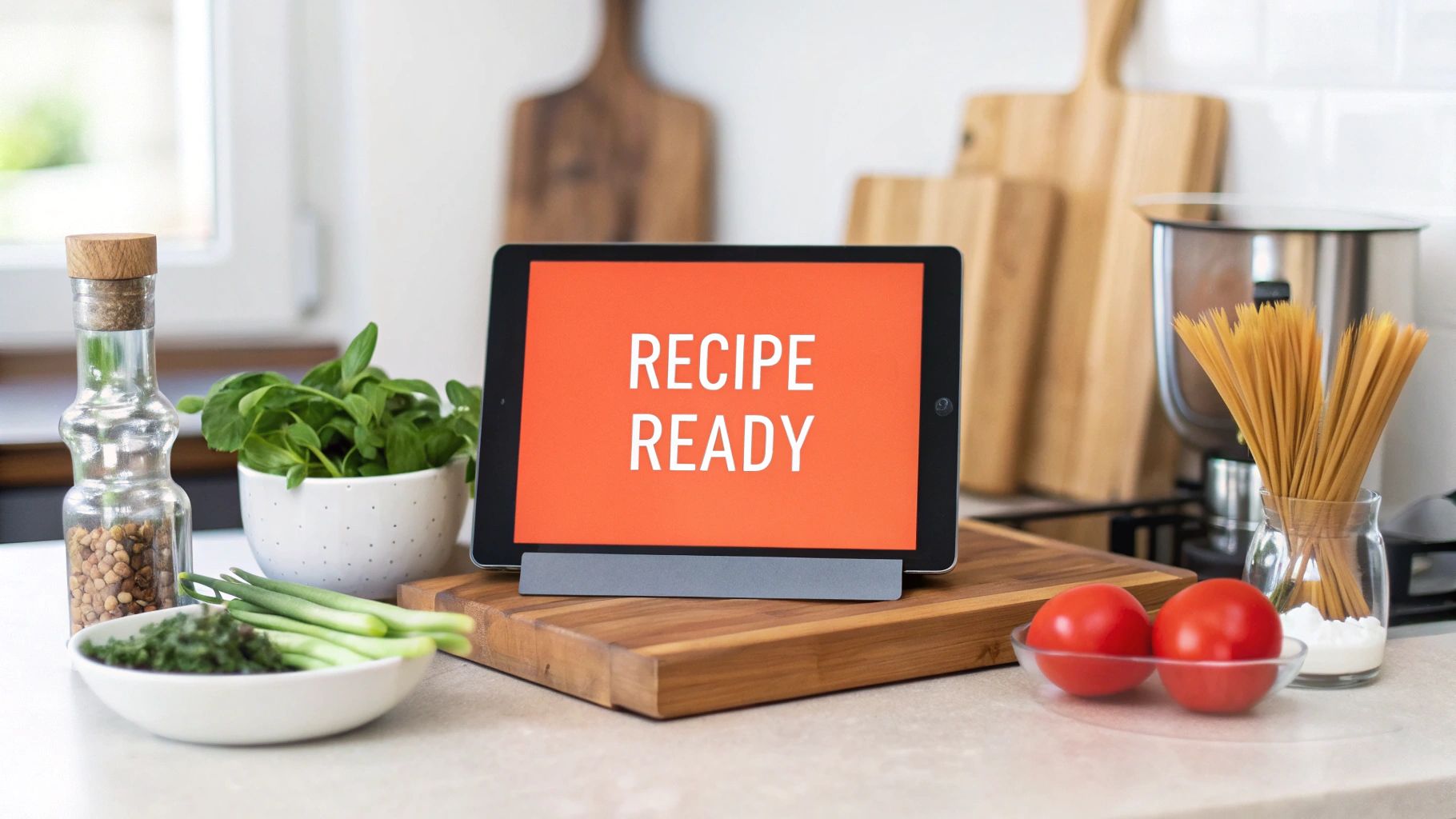Why Traditional Recipe Storage Is Failing Modern Cooks
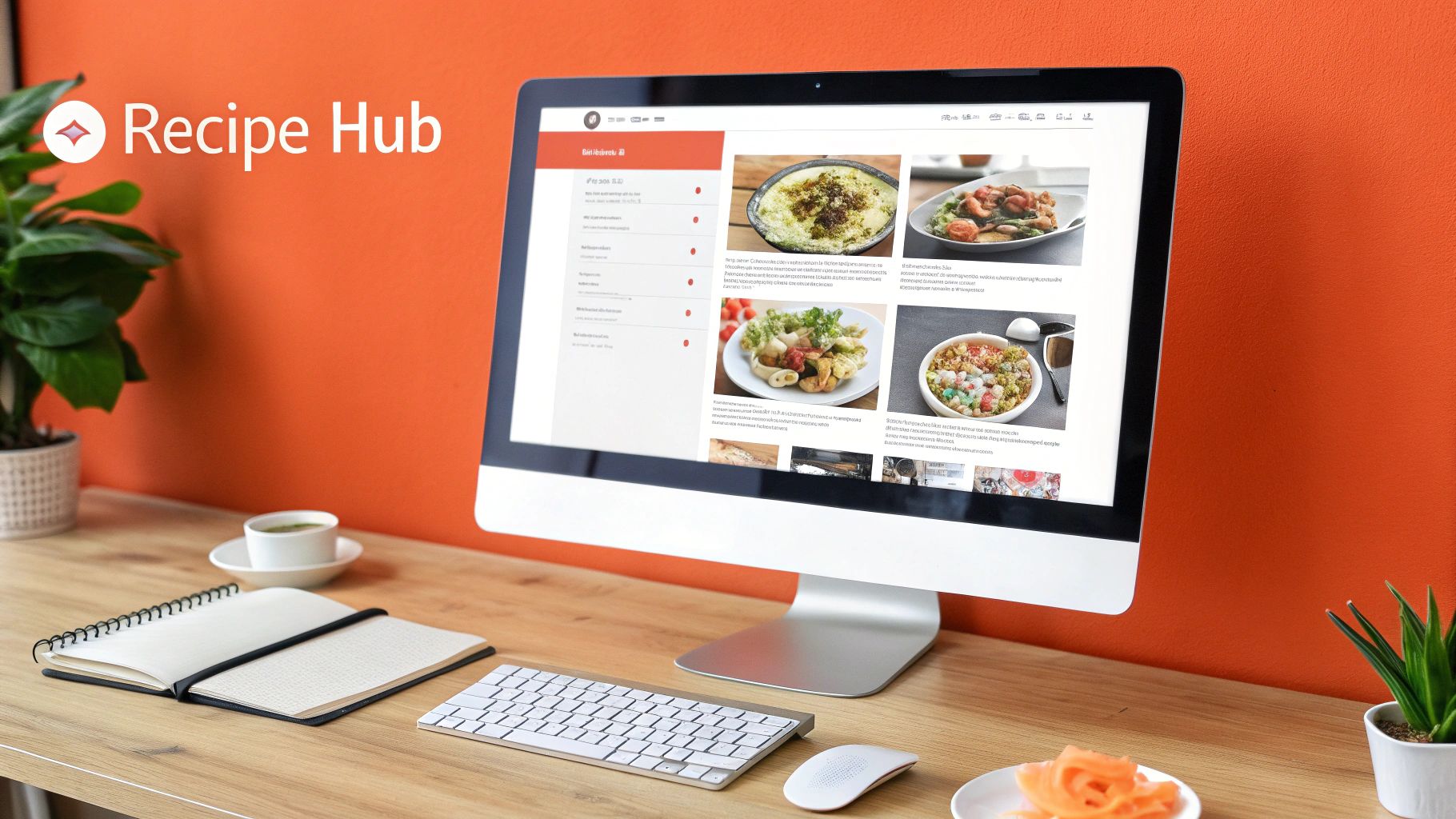
The digital age has changed how we interact with recipes. We're no longer tied to handwritten recipe cards or bulky cookbooks. The internet offers a world of culinary inspiration at our fingertips. However, this abundance has created a new challenge: digital clutter.
Many cooks find themselves overwhelmed by screenshots, overflowing bookmark folders, and countless saved links scattered across different platforms. This scattered approach to recipe storage makes it difficult to find what you need, when you need it.
For example, how much time do you spend each week searching for a specific recipe you know you saved somewhere? This digital scavenger hunt eats into valuable time that could be spent enjoying cooking. Traditional methods also lack the flexibility to effectively categorize and search recipes.
This can lead to cooking the same dishes repeatedly, while other culinary gems remain hidden in the digital abyss.
The Hidden Costs of Recipe Disorganization
This disorganization comes with hidden costs beyond simple inconvenience. Forgotten recipes often lead to reduced meal variety and a reliance on familiar meals. This can stifle culinary creativity and prevent you from exploring new flavors and cuisines.
Furthermore, struggling to find a saved recipe can lead to impulsive takeout orders or resorting to less healthy meal options. This means a disorganized recipe collection can indirectly impact both your budget and your diet.
This growing frustration with traditional methods is fueling the demand for recipe management solutions. The global recipe apps market is projected to reach an estimated USD 14.27 billion by 2033, reflecting the growing demand for convenient and personalized cooking solutions. Discover more insights about recipe app market growth
This clearly shows a shift toward more structured and efficient ways to organize online recipes.
The Benefits of an Organized Approach
Using a systematic approach to recipe organization offers many advantages. Efficiently managing your digital recipe collection can reduce food waste by making it easier to plan meals around ingredients you already have.
It also encourages a more adventurous approach to cooking by providing quick access to a diverse range of options. Perhaps most importantly, a well-organized system instills confidence and inspiration in the kitchen.
This transforms cooking from a chore into a joyful experience. While physical cookbooks might hold nostalgic charm, their digital counterparts offer significantly more potential for truly mastering cooking in the modern age.
Finding Your Perfect Recipe Management Tool
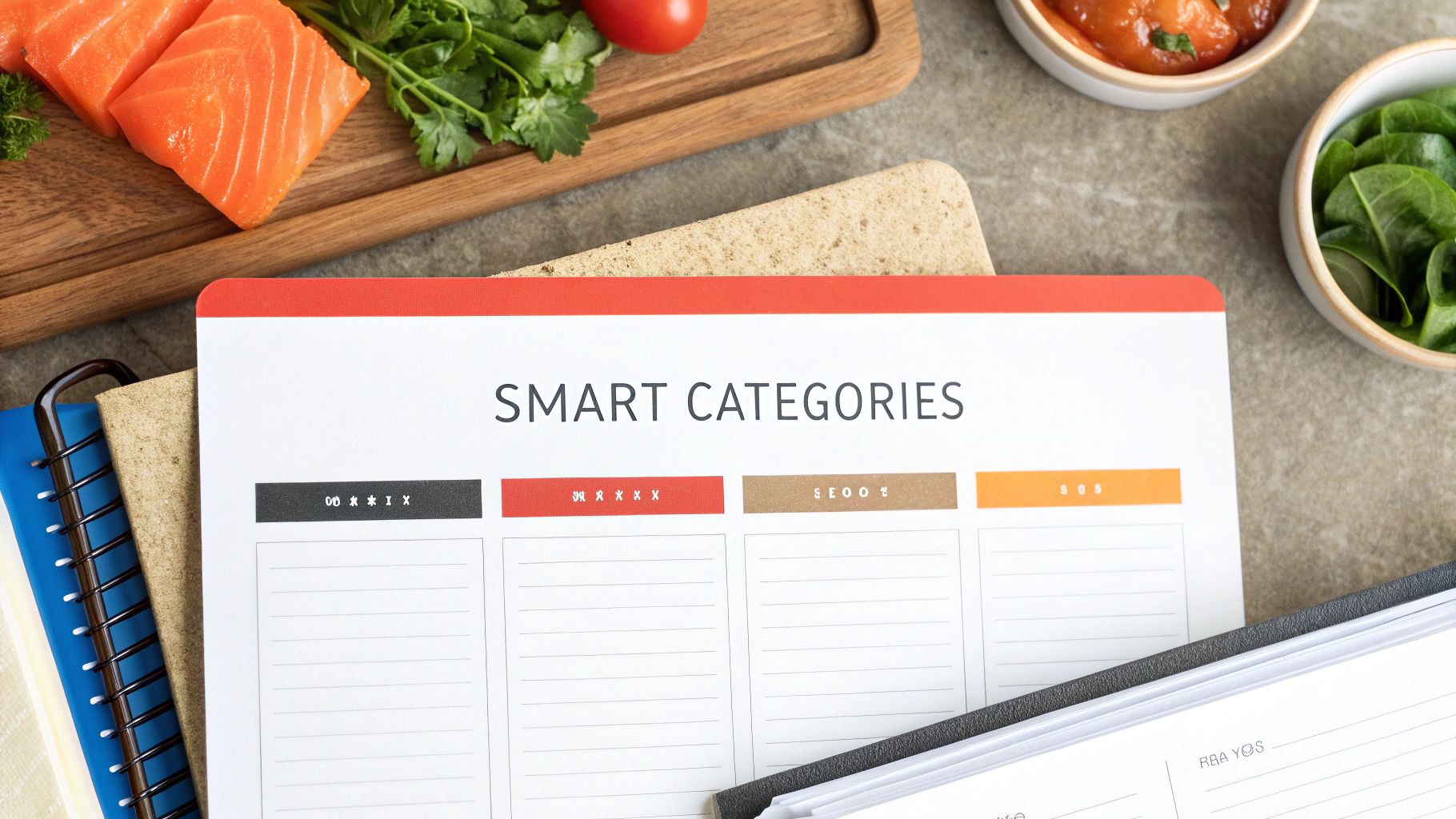
Now that we understand the downsides of disorganized recipes, let's explore some solutions. Choosing the right recipe management tool is key for long-term success. Not all tools are the same, and picking the wrong one can actually make cooking harder. Think carefully about your needs and cooking style before choosing a platform. For more tips, check out this helpful article: How to master digital recipe organization.
Key Features to Consider
Some features are essential for any home cook. Robust search functionality is at the top of the list. You need to quickly find recipes based on keywords, ingredients, or even dietary needs. For example, searching for "chicken and broccoli" should quickly show you all the recipes you need.
Flexible categorization is also important. A good tool lets you tag and categorize recipes in a way that works for you. This could be by cuisine, cooking method, season, or even special occasions.
Cross-device synchronization is also vital. Your recipes should be on your phone, tablet, and computer so you always have them handy.
Exploring Different Platform Types
Different platforms work better for different people. Dedicated recipe apps often have special features like meal planning and grocery lists. Adaptable note systems like Evernote or Notion let you organize recipes any way you like.
Many cooks struggle with physical clutter. This is one reason traditional recipe storage often fails. Exploring general kitchen organization ideas can be helpful.
Web-based platforms offer access from any device with an internet connection. Each platform has pros and cons, so evaluate your needs and technical skills. The recipe website market is growing quickly, projected to reach USD 9.2 Billion by 2033. This shows the increasing popularity of online cooking resources. You can find detailed market analysis here.
To help you choose the right tool, we've compiled a comparison of some popular options:
Popular Recipe Organization Tools Comparison
This table compares the most popular recipe management tools across key features that matter most to home cooks.
| Tool Name | Cost | Available Platforms | Key Features | Best For |
|---|---|---|---|---|
| Paprika Recipe Manager 3 | One-time purchase | iOS, Android, macOS, Windows | Recipe clipping, grocery lists, meal planning, pantry tracking | Cooks who want a dedicated, cross-platform app |
| ChefTap | Free and paid options | Web, iOS, Android | Recipe clipping, grocery lists, meal planning, nutritional information | Cooks who want flexibility and lots of features |
| Plan to Eat | Subscription | Web, iOS, Android | Meal planning, grocery lists, recipe organization | Cooks who prioritize meal planning |
| Evernote | Free and paid options | Web, iOS, Android, macOS, Windows | Note-taking, recipe organization (with some customization) | Cooks who prefer a versatile note-taking system |
This table highlights some of the most popular recipe management tools available. As you can see, there are options for different budgets and preferences. Consider what features are most important to you when making your decision.
Migrating and Future-Proofing Your Collection
Moving your recipes to a new tool can seem overwhelming. However, many platforms offer import options to make it easier. Look for tools that let you import from websites, blogs, and other recipe apps.
Future-proofing your recipes is also important. Choose a platform with export options so your recipes are safe even if the platform shuts down. This lets you easily move to a new system without losing your valuable recipes. By focusing on these key features, you can find a recipe management tool that truly works for you.
Building a Recipe System You'll Actually Use
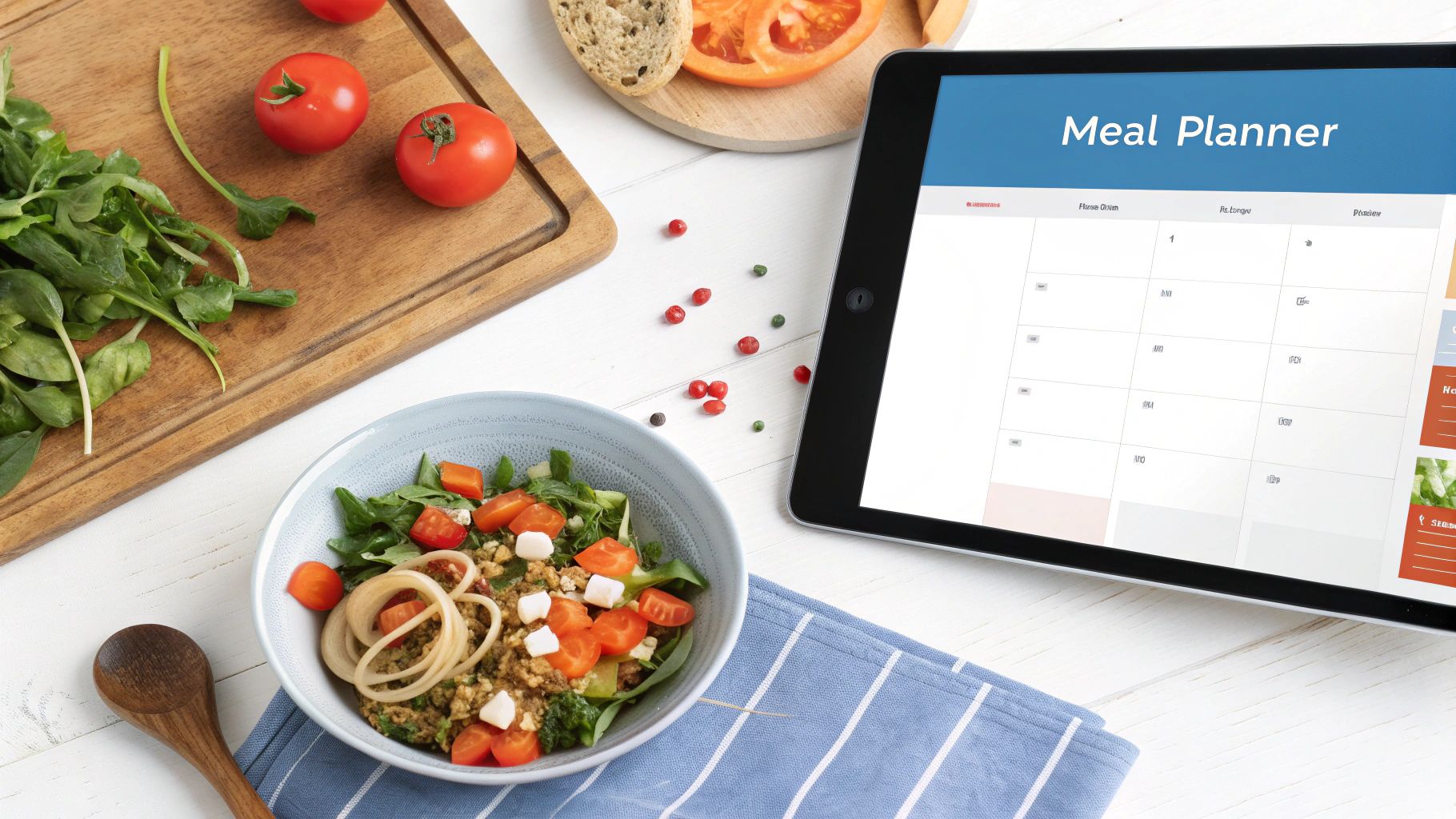
The best recipe software won't do you any good if your organizational system is a mess. A truly effective system reflects how you approach cooking. This means basing your organizational structure on your personal cooking habits. Do you cook by cuisine, available ingredients, or special occasions?
Categorization Approaches That Work
There are several practical ways to organize your recipes. Organizing by cuisine (Italian, Mexican, etc.) is great for exploring different cultures through food. Alternatively, sorting by cooking method (grilling, baking, etc.) helps you find recipes that suit your equipment.
Another helpful approach is categorizing by ingredient. This is perfect for using leftovers or planning meals around what's in your pantry. You can also organize by occasion, such as weeknight meals, holidays, or potlucks. Choose categories that fit your cooking style. The digital recipe consumption market is booming, expected to reach $1.7 billion by 2031. This shows the increasing reliance on digital cooking resources. Learn more here.
The Power of Tagging
A flexible tagging system is vital for effective recipe organization. Tags let recipes belong to multiple categories without duplication. A grilled chicken recipe could be tagged "American," "Grilling," "Chicken," and "Weeknight Dinners."
This multi-faceted approach simplifies finding the right recipe when searching with different criteria. Think of tags as keywords that unlock your recipe collection.
Avoiding Common Pitfalls
Even the best-laid plans can go awry. Overcomplicating the structure is a common pitfall. Too many categories or subcategories make finding recipes difficult. Inconsistent naming is another issue.
For example, using both "Chicken" and "Poultry" creates confusion and inaccurate search results. Keep category and tag names simple and consistent. Finally, review and adjust your system regularly. Your cooking style and preferences change, so your organizational system should too.
Capturing Recipes From Any Source Without Losing Your Mind
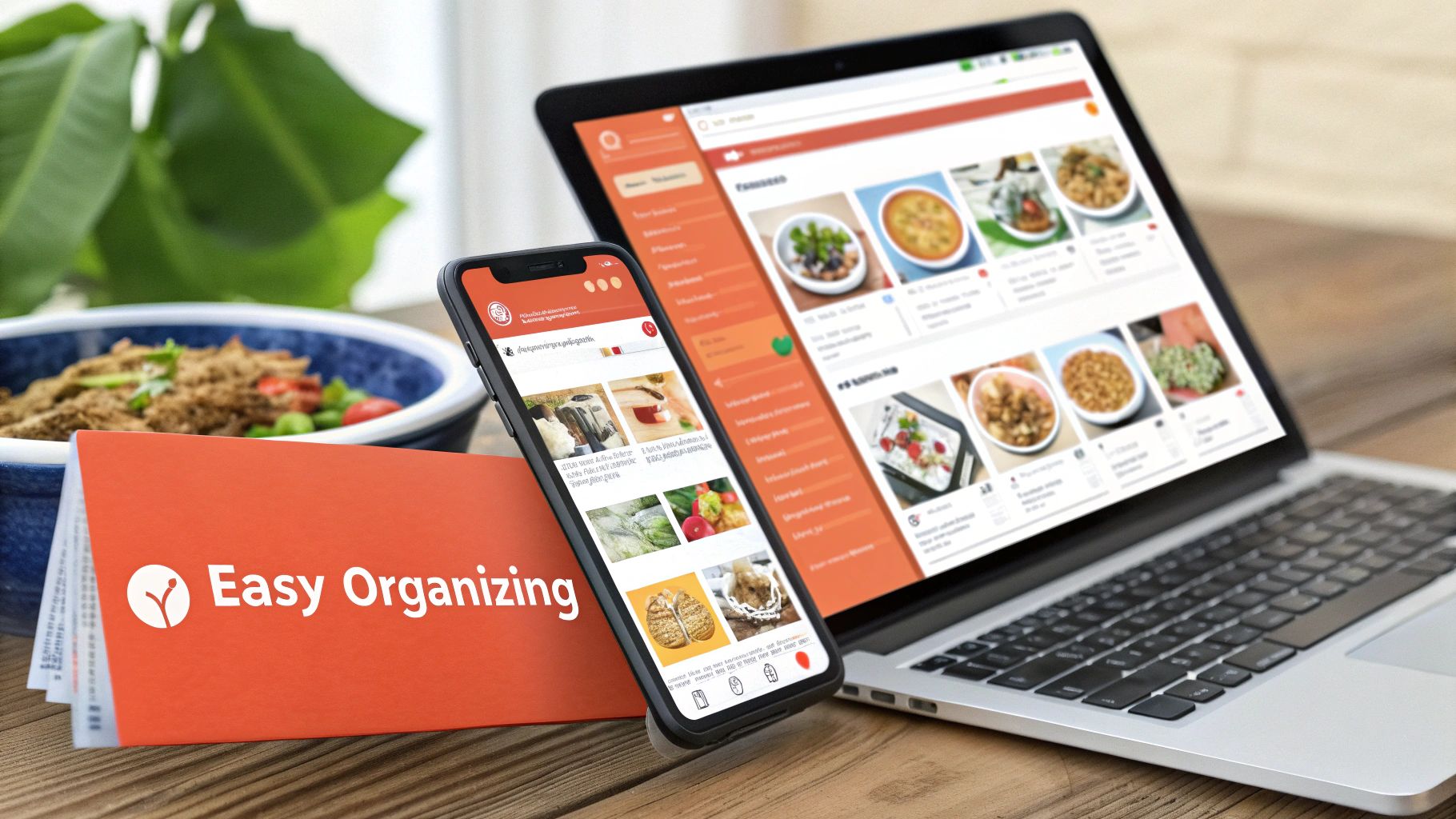
The sheer volume of online recipes can feel overwhelming. While access to culinary inspiration is amazing, keeping it organized can be a real headache. Managing your online recipe collection efficiently is key to a stress-free cooking experience. Let's look at some practical solutions for building a recipe collection that works for you.
Tackling Common Recipe-Saving Frustrations
Social media is great for discovering recipes, but its ephemeral nature makes recipes hard to find later. Recipes shared on platforms like Instagram or TikTok can disappear quickly. Screenshots or recipe-saving apps can help preserve these fleeting finds.
Paywalls are another challenge. Some websites require subscriptions to access their recipes. Consider the value of a subscription versus free resources, or look for similar recipes elsewhere. Video-only recipes can also be problematic. Constantly pausing and rewinding disrupts the cooking flow. Search for written versions or use tools to extract recipe details from videos.
Tools and Techniques for Efficient Capture
Several browser extensions and apps simplify recipe saving. Recipe clipping extensions grab recipe content directly from websites. Recify is one example, allowing you to save recipes from numerous online sources, including YouTube, Instagram, TikTok, and Pinterest.
Not all tools are equally useful. Some add unnecessary complexity. Choose tools that integrate with your existing system and offer a clean, user-friendly interface.
For sites without clipping options, copy and paste is a reliable method. Create a template in your preferred platform (Google Docs is a good option, or within Recify itself) and paste in the recipe details. This creates a consistent format for all your recipes. Always credit the original source with a link.
Evaluating and Standardizing Your Recipes
Not every saved recipe will be a winner. Develop a system for evaluating recipe quality. Look for clear instructions, accurate ingredient lists, and reviews from other cooks.
Once you have a good recipe, standardize it. This might involve shortening ingredient lists, clarifying instructions, or adding personal notes. This helps adapt recipes to your cooking style, increasing the chances you'll make them again.
Ethical Considerations and Supporting Creators
Building a personal recipe collection is a fantastic way to explore new culinary ideas. It's important to do this ethically. Always credit the original creator and, if possible, support their work. Buy their cookbooks, subscribe to their websites, or engage with their social media.
By capturing recipes thoughtfully and supporting creators, you contribute to a vibrant online cooking community and build a valuable resource for your own kitchen. These techniques empower you to create a truly useful and inspiring collection, making the most of the abundant online culinary world.
Transforming Your Collection Into a Meal Planning Powerhouse
A well-organized online recipe collection is more than just a digital cookbook. It's a meal planning powerhouse that empowers you to make quick and informed decisions about what to cook. This efficiency comes from implementing advanced tagging strategies that help you find the perfect recipe for any occasion.
Organizing your recipes with a structured system saves time and reduces the stress of meal planning. By tagging recipes effectively, you create a searchable database tailored to your specific needs and preferences.
Tagging for Success
Think about your usual cooking habits. Do you find yourself short on time during the week? Are there specific dietary needs you have to consider? Do you prefer cooking with seasonal ingredients? A well-designed tagging system takes all these factors into account. For instance, if you are interested in how others organize their recipes, check out this article on How to master recipe organization.
Consider a simple recipe like chicken stir-fry. You could tag it with "30-minutes," "gluten-free," "Asian," "chicken," and "summer." This allows you to search using any of these terms. Need a quick weeknight meal? Search "30-minutes." Craving something gluten-free and seasonal? Combine "gluten-free" and "summer."
This targeted approach narrows down your options, presenting you with a curated selection that fits your exact requirements.
Practical Approaches for Enhanced Organization
Beyond basic tags, consider additional strategies. A "favorites" tag helps track family-approved meals. Noting modifications within each recipe ensures you can easily recreate your personalized versions.
You can also tag recipes for specific events like "holidays," "potlucks," or "birthdays." This minimizes decision fatigue and helps you break free from repetitive meal routines.
Real-World Examples
Meal planning experts often use a combination of techniques. They might create tag categories for dietary restrictions, cuisine types, and cooking methods. This multi-layered approach enables highly specific searches. They might also tag by the main protein source or key ingredients for further refinement.
This detailed tagging structure is far more effective than relying solely on recipe titles. It allows for efficient searching and saves valuable time.
To illustrate the effectiveness of a well-structured tagging system, let's look at a few examples. The table below shows how different tag categories can be used to organize your recipes and the benefits of this approach.
Essential Recipe Tags for Efficient Meal Planning
Key tag categories and examples to implement in your recipe organization system
| Tag Category | Example Tags | Use Case | Benefits |
|---|---|---|---|
| Dietary Needs | Gluten-Free, Vegan, Vegetarian, Dairy-Free | Finding recipes that accommodate specific dietary restrictions | Easily cook for family members or guests with allergies or preferences |
| Cuisine | Italian, Mexican, Indian, Thai | Exploring new flavors and finding recipes for themed meals | Expands culinary horizons and simplifies menu planning |
| Cooking Method | Baking, Grilling, Roasting, Slow Cooker | Finding recipes suited to specific cooking equipment or techniques | Helps use kitchen appliances efficiently and find recipes that fit your available time |
| Time | 30-minutes, 1-hour, Quick, Weeknight | Finding recipes that fit your available time constraints | Reduces stress around cooking and helps stick to meal schedules |
| Season | Spring, Summer, Fall, Winter | Finding recipes that utilize seasonal produce | Encourages using fresh, in-season ingredients and exploring different flavor profiles throughout the year |
As the table demonstrates, using a robust tagging system transforms your recipe collection into a powerful tool. It streamlines your cooking process, so you spend less time searching and more time enjoying the actual cooking and eating.
Creating a Recipe System That Travels With You
Having your recipes readily available, wherever you are, is a game-changer. Whether you're at home in your kitchen or on vacation thousands of miles away, a portable recipe system eliminates the frustration of searching through disorganized files or relying on unreliable internet connections. This lets you focus on what matters most: the joy of cooking.
Ensuring Seamless Synchronization Across Devices
One of the biggest advantages of a digital recipe system is the ability to access your recipes from any device. Cross-device synchronization is essential for true portability. Choosing a platform like Recify that offers seamless syncing across multiple devices means your recipes are always at your fingertips. Whether you're on your phone at the grocery store or your tablet while cooking, it's like having your personal cookbook with you, instantly updated with any changes.
Imagine adding a new recipe on your home computer. With proper synchronization, that recipe will automatically appear on your phone and other connected devices, ready for your next cooking adventure.
Offline Access: Cooking Anywhere, Anytime
Reliable offline access is paramount for a portable recipe system. Picture yourself trying to cook a new dish in a vacation rental with spotty internet. A system that allows you to download recipes for offline viewing prevents this scenario. You'll always have the instructions you need, regardless of internet availability. This is also beneficial for those with unreliable internet connections at home or who prefer to work offline in the kitchen.
Recify offers robust offline capabilities, allowing you to access your curated recipe collection even without an internet connection. This is particularly helpful when traveling or in areas with limited connectivity.
Integrating With Your Cooking Ecosystem
A truly effective recipe system goes beyond simply storing recipes. It integrates with other cooking tools to create a seamless cooking experience. This might include connections to shopping list apps like AnyList or Bring!, making it easy to generate ingredient lists directly from your chosen recipes.
Some platforms even offer integration with smart home systems like Google Home or Amazon Alexa. This integration could allow you to view recipes on a kitchen display or even control appliances based on recipe instructions. This builds a cohesive ecosystem, streamlining your entire cooking process from initial planning to final execution.
Troubleshooting Synchronization Issues
Occasionally, you might encounter synchronization problems. These issues are typically easy to resolve. Start by checking your internet connection and ensuring your recipe app is up to date. If problems persist, try logging out and then back into the app on all your devices. This often fixes minor syncing glitches.
Many recipe apps also offer helpful troubleshooting guides or dedicated customer support for more complex issues. Addressing these potential challenges proactively will ensure a consistently smooth and enjoyable cooking experience. Recify, for instance, provides resources for common sync problems and offers dedicated support to keep your recipes accessible.
By following these strategies, you can build a recipe system that truly goes where you go. This ensures you're always prepared to cook your favorite meals, no matter where your culinary journey takes you.
Maintaining Your Recipe Collection For The Long Haul
A well-organized online recipe collection isn't something you can just set up and forget about. Like a thriving herb garden, it needs regular care to stay useful and inspiring. This means developing sustainable habits that prevent your curated system from becoming cluttered and overwhelming.
Regularly Review And Refresh
Set aside time every few months to review your collection. Think of it as a digital decluttering session. This doesn't have to be a huge chore. Begin by finding recipes you haven't used in the past year. Do they still fit your current tastes and cooking style? If not, consider archiving or deleting them. This keeps your collection focused and easy to navigate. You might be interested in: How to master recipe categorization.
Also, take a look at your tags and categories. As your cooking skills and interests evolve, your organizational system should too. Maybe you've started exploring a new type of cuisine or changed your diet. Update your tags and categories to reflect these changes, making sure your system stays relevant to your current cooking habits.
Documenting Modifications And Personal Touches
As you cook, you’ll naturally make adjustments to recipes – a little more of this, a little less of that. These personal tweaks are what make a dish truly yours. Recording these changes directly within the recipe ensures you can recreate your personalized versions every time. This could be through notes in a "Modifications" section or simply adding comments to the recipe steps. This saves you the frustration of trying to remember exactly what you did differently last time.
Embracing Change: Dietary Shifts And Evolving Preferences
Our tastes and dietary needs change over time. Your recipe collection should adapt to these shifts smoothly. This might mean adding new tags for specific dietary restrictions, such as "gluten-free" or "vegan." You could also create new categories for dietary approaches, like "keto" or "paleo." This flexibility helps you easily filter your collection and find recipes that fit your current requirements.
Backing Up Your Culinary Treasure Trove
Your recipe collection is a precious resource – a record of your culinary knowledge and experiences. Protecting it from data loss is essential. Create a reliable backup system. This could involve regularly exporting your recipes to a separate file or using cloud-based backup solutions.
Consider it an insurance policy for your culinary creations. It gives you peace of mind knowing your hard work is safe. This also makes it easy to transfer your collection to new devices or platforms if needed.
Creating A Family Recipe Archive
Recipes are often more than just instructions; they are cherished family traditions passed down through generations. Digitizing these heirloom recipes preserves them for the future. Create a dedicated section or category for family recipes. Add tags for special occasions or family members associated with each dish. This builds a dynamic archive of culinary heritage, a digital scrapbook of family meals and memories.
Reap The Rewards: Deepening Your Cooking Knowledge
Maintaining your online recipe collection isn't just about organization; it’s about strengthening your connection to food. By reviewing your recipes, documenting modifications, and adapting to your changing preferences, you gain valuable insights into your cooking habits and tastes. This self-awareness makes your collection a powerful tool for culinary growth, helping you become a more confident and creative cook.
Ready to take control of your recipes and enhance your cooking experience? Recify is the all-in-one platform for saving, organizing, and mastering your online recipes. Start organizing your recipes today!
